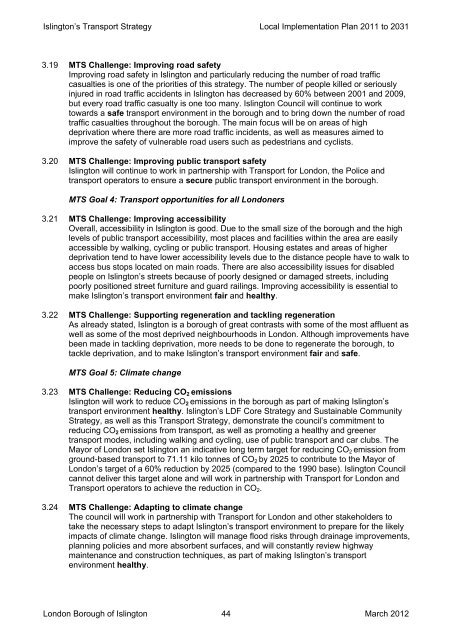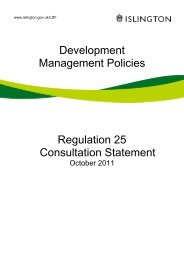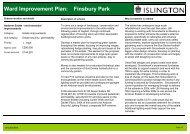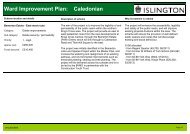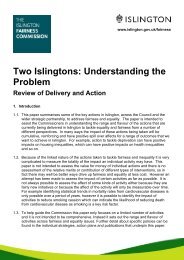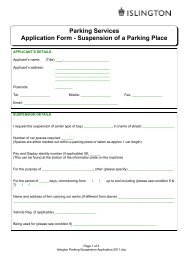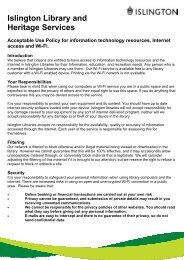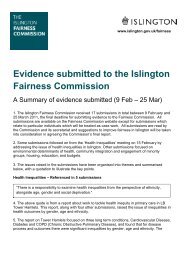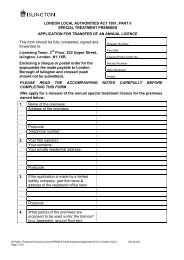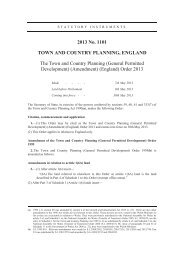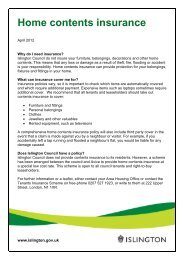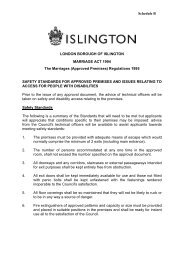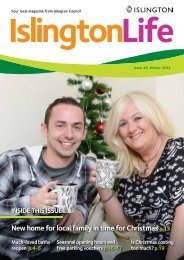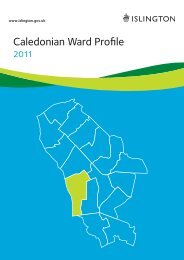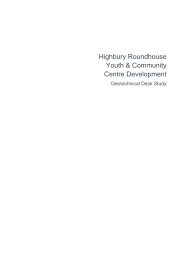Islington's Transport Strategy and Local ... - Islington Council
Islington's Transport Strategy and Local ... - Islington Council
Islington's Transport Strategy and Local ... - Islington Council
You also want an ePaper? Increase the reach of your titles
YUMPU automatically turns print PDFs into web optimized ePapers that Google loves.
<strong>Islington</strong>’s <strong>Transport</strong> <strong>Strategy</strong> <strong>Local</strong> Implementation Plan 2011 to 2031<br />
3.19 MTS Challenge: Improving road safety<br />
Improving road safety in <strong>Islington</strong> <strong>and</strong> particularly reducing the number of road traffic<br />
casualties is one of the priorities of this strategy. The number of people killed or seriously<br />
injured in road traffic accidents in <strong>Islington</strong> has decreased by 60% between 2001 <strong>and</strong> 2009,<br />
but every road traffic casualty is one too many. <strong>Islington</strong> <strong>Council</strong> will continue to work<br />
towards a safe transport environment in the borough <strong>and</strong> to bring down the number of road<br />
traffic casualties throughout the borough. The main focus will be on areas of high<br />
deprivation where there are more road traffic incidents, as well as measures aimed to<br />
improve the safety of vulnerable road users such as pedestrians <strong>and</strong> cyclists.<br />
3.20 MTS Challenge: Improving public transport safety<br />
<strong>Islington</strong> will continue to work in partnership with <strong>Transport</strong> for London, the Police <strong>and</strong><br />
transport operators to ensure a secure public transport environment in the borough.<br />
MTS Goal 4: <strong>Transport</strong> opportunities for all Londoners<br />
3.21 MTS Challenge: Improving accessibility<br />
Overall, accessibility in <strong>Islington</strong> is good. Due to the small size of the borough <strong>and</strong> the high<br />
levels of public transport accessibility, most places <strong>and</strong> facilities within the area are easily<br />
accessible by walking, cycling or public transport. Housing estates <strong>and</strong> areas of higher<br />
deprivation tend to have lower accessibility levels due to the distance people have to walk to<br />
access bus stops located on main roads. There are also accessibility issues for disabled<br />
people on <strong>Islington</strong>’s streets because of poorly designed or damaged streets, including<br />
poorly positioned street furniture <strong>and</strong> guard railings. Improving accessibility is essential to<br />
make <strong>Islington</strong>’s transport environment fair <strong>and</strong> healthy.<br />
3.22 MTS Challenge: Supporting regeneration <strong>and</strong> tackling regeneration<br />
As already stated, <strong>Islington</strong> is a borough of great contrasts with some of the most affluent as<br />
well as some of the most deprived neighbourhoods in London. Although improvements have<br />
been made in tackling deprivation, more needs to be done to regenerate the borough, to<br />
tackle deprivation, <strong>and</strong> to make <strong>Islington</strong>’s transport environment fair <strong>and</strong> safe.<br />
MTS Goal 5: Climate change<br />
3.23 MTS Challenge: Reducing CO 2 emissions<br />
<strong>Islington</strong> will work to reduce CO 2 emissions in the borough as part of making <strong>Islington</strong>’s<br />
transport environment healthy. <strong>Islington</strong>’s LDF Core <strong>Strategy</strong> <strong>and</strong> Sustainable Community<br />
<strong>Strategy</strong>, as well as this <strong>Transport</strong> <strong>Strategy</strong>, demonstrate the council’s commitment to<br />
reducing CO 2 emissions from transport, as well as promoting a healthy <strong>and</strong> greener<br />
transport modes, including walking <strong>and</strong> cycling, use of public transport <strong>and</strong> car clubs. The<br />
Mayor of London set <strong>Islington</strong> an indicative long term target for reducing CO 2 emission from<br />
ground-based transport to 71.11 kilo tonnes of CO 2 by 2025 to contribute to the Mayor of<br />
London’s target of a 60% reduction by 2025 (compared to the 1990 base). <strong>Islington</strong> <strong>Council</strong><br />
cannot deliver this target alone <strong>and</strong> will work in partnership with <strong>Transport</strong> for London <strong>and</strong><br />
<strong>Transport</strong> operators to achieve the reduction in CO 2 .<br />
3.24 MTS Challenge: Adapting to climate change<br />
The council will work in partnership with <strong>Transport</strong> for London <strong>and</strong> other stakeholders to<br />
take the necessary steps to adapt <strong>Islington</strong>’s transport environment to prepare for the likely<br />
impacts of climate change. <strong>Islington</strong> will manage flood risks through drainage improvements,<br />
planning policies <strong>and</strong> more absorbent surfaces, <strong>and</strong> will constantly review highway<br />
maintenance <strong>and</strong> construction techniques, as part of making <strong>Islington</strong>’s transport<br />
environment healthy.<br />
London Borough of <strong>Islington</strong> 44 March 2012


